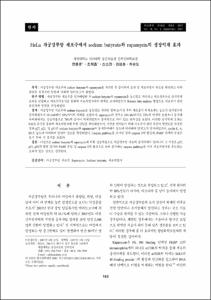KUMEL Repository
1. Journal Papers (연구논문)
1. School of Medicine (의과대학)
Dept. of Obstetrics & Gynecology (산부인과학)
HeLa 자궁경부암 세포주에서 sodium butyrate와 rapamycin의 성장억제 효과
- Alternative Author(s)
- Cho, Chi Heum; Shin, So Jin; Kwon, Sang Hoon; Cha, Soon Do
- Journal Title
- Journal of Gynecologic Oncology
- ISSN
- 2005-0380
- Issued Date
- 2007
- Keyword
- HeLa cell; Rapamycin; Sodium butyrate; Apotosis
- Abstract
- Objective:To evaluate whether mTOR inhibition by rapamycin can enhance the inhibitory effect of sodium butyrate, a histone
deacetylase (HDAC) inhibitor on human cervical cancer cell line HeLa.
Methods: Cervical cancer cells (HeLa) were treated with sodium butyrate alone or in combination with rapamycin. Cell viability
was analyzed by 3-(4,5-dimethylthiazol-2-yl)-2,5-diphenyltetrazolium bromide (MTS) assay and flow cytometry was performed to
ascertain the effects of sodium butyrate and combinations of sodium butyrate with rapamycin. Expression of cell cycle related
proteins were evaluated by Western blot analysis.
Results: As proven previously rapamycin, the mTOR inhibitor was effective in reducing the cell growth of cervical cancer cell
line HeLa. Rapamycin and sodium butyrate induced growth inhibition in a dose dependent manner, with 100 nM/L rapamycin and
10 mM/L sodium butyrate blocked 78% cell growth. FACS analysis data substantiated the competence of rapamycin in inducing
G1 arrest of mammalian cells, and this ability was greatly enhanced by the combination of sodium butyrate and rapamycin. The
percentage of sub G1 fraction of cells was remarkably increased by the combination of sodium butyrate and rapamycin. Sodium
butyrate in combination with rapamycin showed the increased expression of CDK inhibitors p21, p27, and dephosphorylation of
Rb whereas the expression levels of cyclin A, cyclin D1 and cyclin B1 were reduced.
Conclusion: The findings implicate that rapamycin could enhance the anti-cancer effect of sodium butyrate. Further in depth
studies and in vitro studies would throw more light on the growth inhibitory mechanism and its potential use as therapeutic drugs
of butyric acid and rapamycin.
목적:자궁경부암 세포주에 sodium butyrate와 rapamycin을 처리한 후 증식억제 효과 및 세포자멸사 유도를 확인하고 이와
관련된 유전자의 발현에 대하여 알아보고자 하였다.
연구 방법:자궁경부암 세포주를 일차배양한 후 sodium butyrate와 rapamycin을 농도별로 처리하고 세포생존수로 증식억제
효과를 관찰하고 세포주기분석을 통하여 세포자멸사와의 관계를 조사하였으며 Western blot analysis 방법으로 세포주기 관련
유전자의 발현을 측정하였다.
결과:자궁경부암 세포주에 sodium butyrate를 농도별로 처리한 결과 24시간 후의 세포증식 억제효과는 농도가 증가할수록
증가하였으며 10 mM에서 58%까지의 억제를 보였으며, rapamycin의 경우는 100 nM에서도 23%의 억제만 보였으나 동시에
투여하여서는 상승작용으로 78%의 증식이 억제되었으며 통계적으로 의미 있는 유의성을 보였다. 이러한 증식억제 효과는
FACS 분석을 통하여 세포자멸사에 의한 것임을 확인하였으며, 기전을 알아보기 위해 세포주기 관련 유전자 발현도를 측정한
결과 p27, p21, 및 p53은 sodium butyrate와 rapamycin의 동시투여에서 농도에 비례하여 발현도가 증가하였으며, cyclin E, A,
B1은 농도에 비례하여 발현의 감소를 확인하였다. Caspase pathway를 조사한 결과 caspase 3의 활성과, PARP 단백의 분절은
동시 투여 시 증가를 보였다.
결론:이상으로 sodium butyrate와 rapamycin에 의한 상승작용으로 자궁경부암 세포의 증식억제가 일어나며 그 기전은 p27,
p21, p53의 발현 증가와 PARP 분절 및 caspase 3의 활성으로 보아 종국에는 caspase pathway를 거쳐 세포자멸사를 유도하는
효과가 있는 것으로 생각된다.
- Alternative Title
- Treatment with sodium butyrate and rapamycin inhibit growth of human cervical cancer cells
- Department
- Dept. of Obstetrics & Gynecology (산부인과학)
- Publisher
- School of Medicine
- Citation
- 전용준 et al. (2007). HeLa 자궁경부암 세포주에서 sodium butyrate와 rapamycin의 성장억제 효과. Journal of Gynecologic Oncology, 18(3), 165–171.
- Type
- Article
- ISSN
- 2005-0380
- Appears in Collections:
- 1. School of Medicine (의과대학) > Dept. of Obstetrics & Gynecology (산부인과학)
- 파일 목록
-
-
Download
 oak-aaa-2837.pdf
기타 데이터 / 943.33 kB / Adobe PDF
oak-aaa-2837.pdf
기타 데이터 / 943.33 kB / Adobe PDF
-
Items in Repository are protected by copyright, with all rights reserved, unless otherwise indicated.